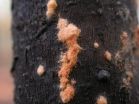(Press-News.org) CORVALLIS, Ore. – Genetic research is showing that healthy steelhead runs in Pacific Northwest streams can depend heavily on the productivity of their stay-at-home counterparts, rainbow trout.
Steelhead and rainbow trout look different, grow differently, and one heads off to sea while the other never leaves home. But the life histories and reproductive health of wild trout and steelhead are tightly linked and interdependent, more so than has been appreciated, a new Oregon State University study concludes.
The research could raise new challenges for fishery managers to pay equally close attention to the health, stability and habitat of wild rainbow trout, the researchers say, because healthy steelhead populations may require healthy trout populations.
In a field study in Hood River, Ore., researchers used DNA analysis to determine that up to 40 percent of the genes in returning steelhead came from wild rainbow trout, rather than other steelhead. And only 1 percent of the genes came from "residualized" hatchery fish – fish that had stayed in the stream and mated, but not gone to sea as intended by the hatchery program.
"It used to be thought that coastal rainbow trout and steelhead were actually two different fish species, but we've known for some time that isn't true," said Mark Christie, an OSU postdoctoral research associate and expert in fish genetic analysis. "What's remarkable about these findings is not just that these are the same fish species, but the extent to which they interbreed, and how important wild trout are to the health of steelhead populations."
This research, just published in the journal Molecular Ecology, was based on a 15-year analysis of 12,725 steelhead from Oregon's Hood River, each of which was sampled to determine its genetic background and parentage. It was supported by funding from the Bonneville Power Administration.
The study reveals a complex picture of wild trout and steelhead intermingling as they reproduce. A steelhead might be produced by the spawning of two steelhead, two wild trout, or a returning steelhead and a trout.
Rainbow trout are small to moderate-sized fish in most rivers, but if that same fish migrates to the ocean it can return as a huge steelhead weighing 30 pounds or more, prized for sport fishing. Researchers still don't know exactly why some trout choose to go to the ocean and others don't, although they believe at least some part of the equation is genetic.
Studies of rainbow trout and steelhead have been undertaken, in part, to better understand the implications of hatcheries. Including all salmonid species, more than one billion hatchery salmon are released into Pacific Northwest streams each year. And because hatcheries produce fish that are less able to survive and successfully reproduce in the wild, there is concern about hatchery fish mating with wild fish.
"One implication of this study is that the genetic contribution by wild trout is diluting the input of genes from hatchery fish to the wild steelhead population," said Michael Blouin, an OSU professor of zoology and co-author on this study.
"The genetic influences of hatchery fish on wild steelhead populations are still a concern," Blouin said. "But the good news from the Hood River is that the hatchery genes are being diluted more than we thought, and thus may not be having as much impact on dragging down the fitness of the wild steelhead."
The genetic influence of wild rainbow trout, the scientists said, is roughly cutting in half the genetic input of hatchery fish that reproduce in the wild – a mitigation of their impact that's of some importance.
The scientists cautioned that results from one river might not be representative of all steelhead populations. Nevertheless, Christie said, "The importance of trout in maintaining steelhead runs should not be underestimated.
"They can act as a healthy genetic reservoir and preserve reproductive populations during years when ocean conditions make steelhead survival very difficult," he said. "So a good way of looking at it is, whatever is good for wild rainbow trout is also good for steelhead."
Worth noting, the researchers said, is that most other salmonids, such as coho or chinook salmon, do not have this type of fall-back system to help produce fish with a higher capability of surviving. As such, they may be more vulnerable than steelhead to the concerns about genetic weaknesses produced by hatchery fish.
###
Editor's Note: A digital image of a male steelhead is available online: http://www.flickr.com/photos/oregonstateuniversity/5393667921/
END
Numerous nanomaterials are currently at the focus of public attention. In particular silver nanoparticles are being investigated in detail, both by scientists as well as by the regulatory authorities. The assumption behind this interest is that they are dealing with a completely new substance. However, Empa researchers Bernd Nowack and Harald Krug, together with Murray Heights of the company HeiQ have shown in a paper recently published in the journal Environmental Science & Technology that nanosilver is by no means the discovery of the 21st century. Silver particles with ...
Offering the morning after pill free over the counter has not reduced the number of teenage pregnancies and may be associated with a rise in sexually-transmitted diseases (STIs), according to a report by experts at The University of Nottingham.
Professors David Paton and Sourafel Girma used local health authority data to study the impact that the introduction of Government-backed schemes to offer emergency birth control at pharmacies and without prescription have had on conception rates and the diagnosis of STIs among under-18s.
Their findings show that, on average, ...
Geneva, 31 January 2011. CERN today announced that the LHC will run through to the end of 2012 with a short technical stop at the end of 2011. The beam energy for 2011 will be 3.5 TeV. This decision, taken by CERN management following the annual planning workshop held in Chamonix last week and a report delivered today by the laboratory's machine advisory committee, gives the LHC's experiments a good chance of finding new physics in the next two years, before the LHC goes into a long shutdown to prepare for higher energy running starting 2014.
"If LHC continues to improve ...
Chestnut Hill, Mass. (1/31/2011) – Red Bull's red and gold logo can "give you wings" – for better or worse – even if consumers don't know it, according to a new study by two Boston College professors, who found the brand's edgy marketing efforts have sold a heavy dose of attitude to consumers.
Researchers put subjects at the controls of a car racing video game, supplying each with functionally identical racecars, but each car decorated with a different brand logo and color scheme.
Players put in control of the Red Bull car displayed the characteristics often attributed ...
The more we learn about biology, the closer we get to being able to treat disease – and the more complicated our understanding of disease itself becomes.
A new research finding showing a strong relationship between complex microbial ecologies in human intestines and the common but serious medical condition known as fatty liver illustrates this paradox.
From past genomic studies, we have learned that a mind-boggling multitude of different kinds of benign bacteria inhabit our intestines and that these populations can vary almost infinitely from one human being to the ...
Boston, MA—Scientists have found that free radicals (unstable molecules that cause the death of cells as the body ages) may also cause the damage in the eyes of patients with Fuchs Endothelial Corneal Dystrophy (FECD), a hereditary disease that is one of the most common reasons for corneal transplants worldwide.
The finding, published in the November 2010 American Journal of Pathology, holds promise for early and preventative treatments for this disease, which impacts nearly four percent of the population over age 60.
"Our discovery is significant, because it gives ...
Berkeley – In a demonstration of "reverse-ecology," biologists at the University of California, Berkeley, have shown that one can determine an organism's adaptive traits by looking first at its genome and checking for variations across a population.
The study, to be published the week of Jan. 31 in the journal Proceedings of the National Academy of Sciences, offers a powerful new tool in evolutionary genetics research, one that could be used to help monitor the effects of climate change and habitat destruction.
The researchers scanned the genes of 48 different strains ...
The scientists have now carried out the first full run of experiments that smash protons together at almost the speed of light. When these sub-atomic particles collide at the heart of the CMS detector, the resultant energies and densities are similar to those that were present in the first instants of the Universe, immediately after the Big Bang some 13.7 billion years ago. The unique conditions created by these collisions can lead to the production of new particles that would have existed in those early instants and have since disappeared.
The researchers say they are ...
New Haven, Conn.—A team of Yale University scientists has synthesized for the first time a chemical compound called lomaiviticin aglycon, leading to the development of a new class of molecules that appear to target and destroy cancer stem cells.
Chemists worldwide have been interested in lomaiviticin's potential anticancer properties since its discovery in 2001. But so far, they have been unable to obtain significant quantities of the compound, which is produced by a rare marine bacterium that cannot be easily coaxed into creating the molecule. For the past decade, different ...
Researchers at National Jewish Health have discovered a signaling pathway that is crucial to the devastating effects of acute lung injury (ALI). The data, obtained from cells, animals and ALI patients, suggest several potential therapeutic targets. Experimental blockade of one of the targets significantly reduced flooding of the lungs that is the hallmark of ALI.
"Acute lung injury is a devastating disease, with 40 percent mortality and no beneficial therapies," said first author James Finigan, MD, Assistant Professor of Medicine at National Jewish Health. "Our study ...

